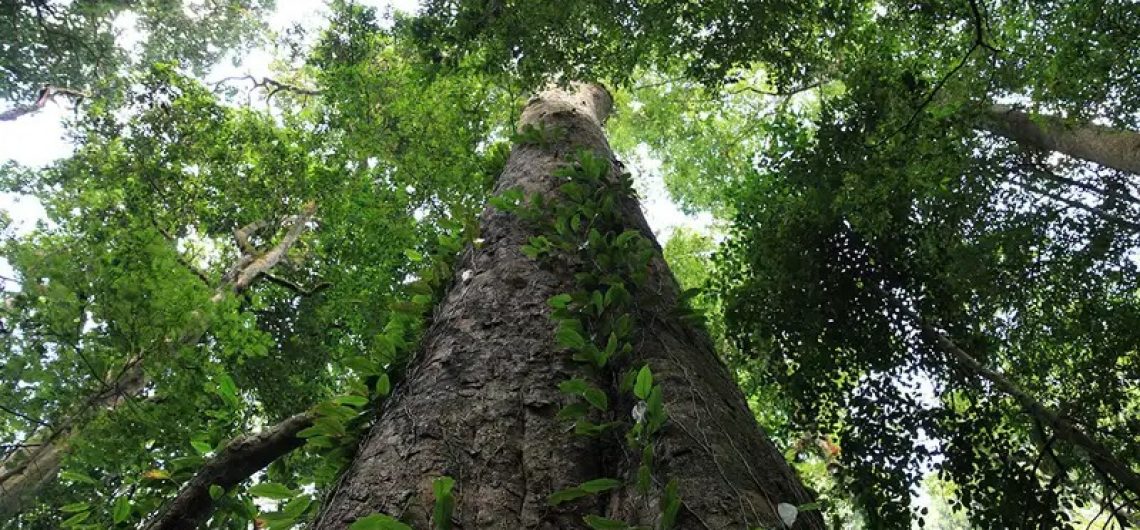Africa’s tallest tree has been discovered on Mount Kilimanjaro and it comes with no surprise at all as this is where the tallest mountain in Africa is located. It most certainly is a contender for the tallest tree in the continent of Africa. An isolated valley on the highest peak in the continent, Kilimanjaro, is home to Africa’s tallest native tree, which stands at an incredible 81.5 meters.
The imported Sydney blue gum (Eucalyptus Saligna) specimen in Limpopo, South Africa, which perished in 2006, set the previous record for the tallest tree in Africa. The colossus in Tanzania has now surpassed that mark.
Twenty years ago, while investigating Mount Kilimanjaro’s vegetation, Andreas Hemp of the University of Bayreuth in Germany discovered a group of towering Entandrophragma excelsum trees. However, it took a while for him and his crew to be able to precisely measure their heights using new instruments.
Between 2012 and 2016, they used laser tools to measure 32 specimens, and they discovered that the 10 highest ones varied in height from 59.2 to 81.5 meters and in diameter from 0.98 to 2.55 meters. Hemp calculates that the arboreal behemoths are 500–600 years old based on growth rates.
The tallest trees in the world are often not located in Africa; a 116-meter-tall sequoia tree may be found in North America, and a 100-meter-tall eucalyptus can be found in Australia.
This is largely due to a lack of research on African trees, which leads to the understudied nature of many of the continent’s tree species, as well as the fact that many of the continent’s tree species thrive in areas with little resources, which restrict them from growing too tall.
The latter is not the case in Kilimanjaro, where the growth of E. excelsum has likely been aided by a mix of nutrient-rich volcanic soils, high temperatures, and precipitation.
Africa’s tallest Indigenous tree -Entandrophragma excelsum
Entandrophragma excelsum is a tree species that belongs to the family Meliaceae. It is native to the African continent and can be found in several countries, including Ghana, Ivory Coast, and Cameroon. The tree can grow up to 50 meters tall, with a trunk diameter of up to 2 meters. The bark is smooth and gray-brown, while the leaves are compound and up to 30 cm long.
Characteristics of Entandrophragma Excelsum
Entandrophragma excelsum is a versatile and durable hardwood with a range of desirable characteristics, including:
- Color: The heartwood of Entandrophragma excelsum is reddish-brown, with a golden luster that becomes more pronounced with age. The sapwood is pale yellow or white.
- Density: The wood is moderately dense, with an average density of 0.59 g/cm3 at 12% moisture content.
- Grain: The grain is interlocked, which gives the wood excellent stability and resistance to warping.
- Texture: The wood has a medium texture and a natural luster that polishes to a high sheen.
Uses of Entandrophragma Excelsum
Entandrophragma excelsum is a highly valued timber species due to its versatility and durability. It is commonly used in a variety of applications, including:
Furniture
Entandrophragma excelsum is a popular choice for furniture makers due to its rich color and natural luster. The wood is easy to work with and can be shaped into a range of designs and styles. African mahogany furniture can range from traditional to modern, making it a versatile option for any decor.
Flooring
Entandrophragma excelsum is an excellent choice for flooring due to its strength and durability. The wood is resistant to wear and tear and can withstand heavy foot traffic without showing signs of wear. The natural luster of African mahogany also adds a touch of elegance to any room.
Paneling
Entandrophragma excelsum is commonly used for wall paneling due to its rich color and natural luster. The wood can be used in both traditional and modern settings, adding warmth and sophistication to any space.
Boatbuilding
Entandrophragma excelsum is a popular choice for boatbuilders due to its strength and durability. The wood is resistant to rot and insect infestation, making it an ideal choice for marine environments.
Musical Instruments
Entandrophragma excelsum is a popular choice for musical instrument makers due to its excellent resonance and tonal qualities. The wood is commonly used for guitar bodies, piano keys, and other musical instruments.
Environmental Impact of Entandrophragma Excelsum
Entandrophragma excelsum is a valuable timber species that is harvested from natural forests in Africa. While the wood is highly desirable, it is important to consider the environmental impact of harvesting and processing African mahogany. Sustainable harvesting practices, such as selective logging and reforestation, can help ensure the long-term survival of this valuable species.
Kilimanjaro: Africa’s Tallest Tree
When most people think of Kilimanjaro, they think of the famous mountain that towers over the surrounding landscape in Tanzania. However, Kilimanjaro is also the name of Africa’s tallest tree, a giant that stands out even amongst the impressive natural wonders found on the continent.
Introduction: The Magnificent Kilimanjaro Tree
The Kilimanjaro tree, scientifically known as Entandrophragma excelsum, is a species of hardwood tree that can grow up to heights of over 80 feet (24 meters). These giants are found in the forests of East Africa, including in Kenya and Tanzania. In this article, we will explore the fascinating features and characteristics of Kilimanjaro, Africa’s tallest tree.
The Majestic Kilimanjaro Tree
The Kilimanjaro tree is a true marvel of nature, with its massive size and impressive features. These trees have thick trunks that can reach diameters of up to 10 feet (3 meters) and branch out into a wide canopy of leaves and branches. Kilimanjaro trees are essential to the health of the surrounding ecosystem, providing shelter, food, and resources for a variety of animals and plants.
Anatomy of the Kilimanjaro Tree
The Kilimanjaro tree has a unique anatomy that sets it apart from other trees. These giants have thick, rough bark that protects them from damage and pests. The trunk of a Kilimanjaro tree can store large amounts of water, making it a vital source of hydration for animals and humans during the dry season.
The Kilimanjaro’s branches grow outwards from the top of the trunk and can reach lengths of up to 50 feet (15 meters). The tree’s leaves are large and compound, with up to 15 leaflets arranged on each leaf. The Kilimanjaro tree’s flowers are small and white and are followed by woody fruits that contain seeds.
Distribution of the Kilimanjaro Tree
The Kilimanjaro tree is found primarily in the forests of East Africa, including in Tanzania’s Kilimanjaro National Park. These trees are also found in Kenya, Rwanda, and Uganda. The Kilimanjaro tree is considered endangered due to habitat loss and deforestation, and efforts are underway to protect and preserve this magnificent species.
Frequently Asked Questions (FAQs)
What makes Kilimanjaro the tallest tree in Africa?
- Kilimanjaro is the tallest tree in Africa due to its impressive height and large trunk diameter.
Where can I see Kilimanjaro trees?
- Kilimanjaro trees are primarily found in the forests of East Africa, including in Tanzania’s Kilimanjaro National Park.
How old can Kilimanjaro trees get?
- Kilimanjaro trees can live for hundreds of years, with some estimated to be over 500 years old.
Why are Kilimanjaro trees endangered?
- Kilimanjaro trees are endangered due to habitat loss and deforestation.
What is being done to protect Kilimanjaro trees?
- Efforts are underway to protect and preserve Kilimanjaro trees, including through reforestation efforts and protected areas.
What is the scientific name of the Kilimanjaro tree?
- The scientific name of the Kilimanjaro tree is Entandrophragma excelsum.
Sustaining and supporting life
The enormous trees are an integral part of the thriving ecology on the mountain, where they are home to ferns and a variety of other plants that rely on them for physical support. Hemp describes them as “like a metropolis in the jungle.”
However, illegal logging, which has devastated their priceless environment, poses a threat to the green giants. Therefore, the team advises that for protection, the valleys home to the giants be included to the nearby Kilimanjaro National Park.
This viewpoint is shared by David Seaborg of the World Rainforest Fund in Walnut Creek, California. The richness of plants, birds, and insects that benefit from the presence of trees, he notes, may also be preserved if we maintain the trees.
Read also about the highest pizza delivery in the world
![]()


Comments